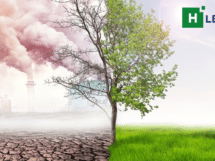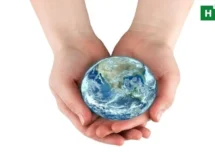Forests are supposed to fight climate change, but in India’s case opposite could be true: forests could succumb to climate change if no urgent ameliorative measures are taken.
By 2050, nearly all of India’s forest cover will figure as climate change hotspots, which means they will be at greater risk of climate change than other regions. This would not only threaten the survival of forests but also affect the forest-dependent communities leading, in turn, to large-scale migration, public health concerns and climate refugees.
India is one of the ten most forest-rich nations in the world. But last November, at the Glasgow Leaders Declaration on Forests and Land Use, when 141 countries committed to working collectively to halt and reverse forest loss and land degradation by 2030, India stayed away. While the world leaders agreed to “deliver sustainable development and promote an inclusive rural transformation,” India, claimed to register a growth of 5.7 percent increase in its forest cover.
India’s forests are thriving – India State of Forest Report (ISFR) by the Forest Survey of India (FSI) noted in its 17th biennial edition published in November 2021. In the last two decades, says the report that forest cover has grown around 40,000 sq. km – an area roughly the size of the Indian state Haryana. However, the report explains that 45-64 percent of India’s forest cover will figure as climate change hotspots in less than ten years, and by 2050 it will extend to the entire Indian forest cover. The climate change hotspots are areas where strong physical and ecological effects of climate change are visible, along with large vulnerable and forest-dependent communities.
Environmental experts then question why India stayed away from signing the Glasgow agreement. One reason they say is that India disapproved of linking infrastructure development and related activities with the conservation of forests. Instead, the Glasgow Declaration linked transformative actions to sustainable production and consumption, infrastructure development, trade, finance, and investment.
The ISFR on the other hand, also mentioned that the biodiversity-rich forests in the north-eastern region of India have been recording a loss of forest cover since 2009, leading to climate hotspots in the region. Hence, environment experts point to the dichotomy in the government’s response, questioning first the method of counting forest land. They say the method may be faulty. The sensor technique used to identify forests counts even small patches of trees and greens as forests.
Noted environmentalist Dipayan Dey of the South Asian Forum of Environment (SAFE)- a Kolkata-based NGO working on wetlands conservation says that the report impacts other definitions. “If the ISFR 2021 agrees to the definition of its forests, many of the city dwellers or tea plantation, coffee plantation owners are forest dwellers; but if these areas called forests now consider applying under the Forest Conservation Act 1980, these areas will likely not meet the qualification of a “forest.”
Hence, impacts of climate hotspots might then not be addressed effectively, as committed by global leaders, which means committing to “policies and systems to accelerate the transition to a resilient economy that advances forest, sustainable land use, biodiversity, and climate goals.”.
The computer-modeled projection of ISFR mapped climate change hotspots of Indian forests based on temperature and rainfall data for the three future time -periods– 2030, 2050, and 2085. It said that climate change will impact climatic hotspots and experience changes in temperature and rainfall. The report predicted that by 2030 almost 45-64 percent of India’s forest cover will fall under climate hotspots. It said by the year 2050 entire forest cover of the country will be estimated to be covered under climate change hotspots with varying severity. By 2085, 20 percent of India’s forest cover may experience “catastrophic changes due to adverse impact of climate change.” The areas that will experience catastrophic effects include territories of Jammu and Kashmir, Himachal Pradesh, Uttarakhand, and north-eastern states such as Assam, Manipur, Mizoram, Meghalaya, Tripura, and some parts of central India and Gujarat.
Forests are our planet’s lungs and they absorb almost one third of the global carbon dioxide released from burning fossil fuels every year. Currently, nearly 23 percent of global emissions come from land-use activity, such as logging, deforestation, infrastructure development, and farming. Protecting forests and reducing damaging land use is one of the crucial measures to restrict catastrophic global warming and its impacts on the lives and futures of the 1.6 billion people worldwide — nearly 25 percent of the world’s population — who rely on forests for their livelihoods.
At COP 26, the signing countries pledged to reduce vulnerability, build resilience and enhance rural livelihoods. This effort would include empowering communities, developing profitable, sustainable agriculture, and recognizing multiple values of forests and the rights of indigenous peoples and local communities according to relevant national legislation and international instruments. That is why India’s absence from the Glasgow declaration is disappointing. While India is counting growth in its forest land and talks about the growing climate hotspots that will have non-reversible impacts on human life, it stays away from committing to actionable items that mitigate the damage.
In the mangrove area of Sundarbans in West Bengal- the delta region and the world’s one of the most vulnerable ecosystems, several villages face the climate change impact directly. Such is the condition that areas in the low coastal zone face natural disasters such as floods, cyclones, relative sea-level rise, and coastline erosion much more aggressively than before. Some studies show that climate change leads to increased salinity, higher tidal surges, and permanent submergence of landmass. These will have adverse effects and loss of critical biodiversity habitats, fauna, and flora. And hence the climate change impacts will have large-scale uprooting of people due to the sea level rise, migration, public health issues, and the creation of India’s climate refugees.
















